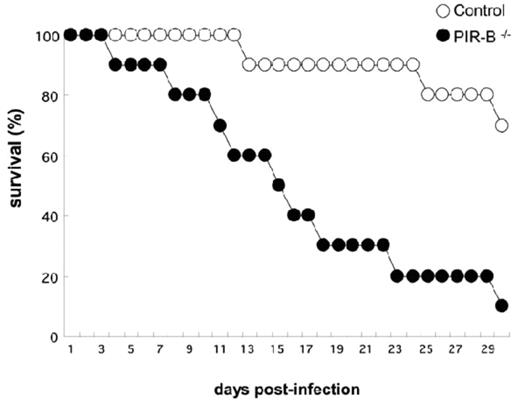Abstract
Paired Immunoglobulin-like receptors of activating (PIR-A) and inhibitory (PIR-B) isoforms are expressed by many blood cell types including B cells, dendritic cells, monocyte/macrophages, granulocytes, mast cells and megakaryocyte/platelets. To determine the role of PIR-B in bacterial infection, PIR-B deficient (PIR-B−/−) and control C57BL/6 mice of the same age and sex were infected intravenously with the attenuated strain of Salmonella typhimurium (WB335). When injected with high doses of bacteria (5 × 104 ∼ 5 × 106 CFU), both types of mice died within 3 to 14 days post infection. When given small doses (103 ∼ 104 CFU), however, PIR-B−/− mice exhibited progressively increasing morbidity beginning at 4-day post-infection over a 4-week period, whereas many control mice could survive (see Figure). PIR-B−/− mice were found to have higher bacterial loads in liver, spleen and lungs than the control mice and bacteremia at days 3 and 7 post-infection. In liver histology typhoid nodules were observed as early as day 1 and their incidence increased during the next six days in both groups of mice. However, quite distinct changes were observed at day 7: in control mice inflammatory cellular lesions were localized and exhibited nodular distribution, whereas in PIR-B−/− mice mononuclear cells infiltrated along the liver sinusoids and exhibited a spreading distribution. There were no significant differences in plasma levels of liver enzymes (ATL, AST and ALK), cytokines (TNFα, IL-10 and IFNγ) and antibodies (IgM, IgG and IgA) against Salmonella between PIR-B−/− and control mice. While splenic lymphoid and myeloid subsets were indistinguishable during the first week of infection, the increases of CD19+ B and CD8+ T cells in infected PIR-B−/− mice were not as marked as those in infected control mice at day 14 post-infection (see Table). For phagocytic cell functions ex vivo, there were no differences in phagocytosis and intracellular killing of bacteria and superoxide anion release between PIR-B−/− and control mice. However, PIR-B−/− macrophages were found to release more nitrite and TNFα upon bacteria stimulation than the control macrophages. These results suggest that PIR-B plays an important regulatory role in bacterial infection.
(Supported by NIH/NIAID grants AI42127 and AI52243).
| . | Mac-1+ MΦ . | CD4 + T . | CD8+ T . | CD19+ B . |
|---|---|---|---|---|
| cell numbers (× 107), mean ± 1 S.D. | ||||
| Uninfected Control | 1.3 ± 0.6 * | 1.4 ± 0.4 | 0.7 ± 0.3 | 5.1 ± 1.8 |
| Uninfected PIR-B−/− | 1.2 ± 0.3 | 1.5 ± 0.2 | 1.2 ± 0.2 | 4.9 ± 0.3 |
| Infected Control | 19.4 ± 7.0 | 5.5 ± 1.5 | 2.6 ± 0.7 | 10.0 ± 2.6 |
| Infected PIR-B−/− | 16.5 ± 2.3 | 4.2 ± 2.1 | 1.3 ± 0.6 | 4.5 ± 1.3 |
| . | Mac-1+ MΦ . | CD4 + T . | CD8+ T . | CD19+ B . |
|---|---|---|---|---|
| cell numbers (× 107), mean ± 1 S.D. | ||||
| Uninfected Control | 1.3 ± 0.6 * | 1.4 ± 0.4 | 0.7 ± 0.3 | 5.1 ± 1.8 |
| Uninfected PIR-B−/− | 1.2 ± 0.3 | 1.5 ± 0.2 | 1.2 ± 0.2 | 4.9 ± 0.3 |
| Infected Control | 19.4 ± 7.0 | 5.5 ± 1.5 | 2.6 ± 0.7 | 10.0 ± 2.6 |
| Infected PIR-B−/− | 16.5 ± 2.3 | 4.2 ± 2.1 | 1.3 ± 0.6 | 4.5 ± 1.3 |
Figure
Author notes
Disclosure: No relevant conflicts of interest to declare.


This feature is available to Subscribers Only
Sign In or Create an Account Close Modal